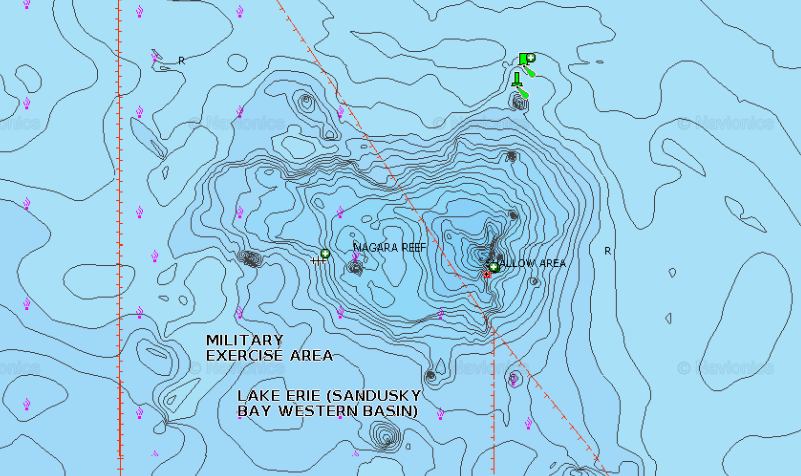As you look out over Lake Erie, have you ever wondered what lies beneath the surface? Lake Erie is full of underwater structure. In this article, we take a look at the top 5 facts about Niagara Reef Lake Erie.
Niagara Reef is located in the western basin of Lake Erie and is a hotspot for fishing and diving. It is part of an area called the “reef complex.” This area of Lake Erie is the most shallow part. It often has silty runoff and sometimes algae blooms in the summer. Let’s take a closer look at each of these 5 facts about Niagara Reef on Lake Erie.
Fact 1: The Origins of Niagara Reef on Lake Erie
Niagara Reef didn’t just pop up overnight. Geologists believe the reef formed during the last ice age, roughly 12,000 years ago. As massive glaciers retreated, they scraped and sculpted the lake bed, leaving behind a series of ridges and depressions. When this movement was happening, shoals were formed by ice-pushing ground material.
The reef’s composition tells a geological story. It’s primarily made up of dolomite, limestone, and shale. These sedimentary rocks are riddled with fossils, offering a window into Lake Erie’s ancient past. Over millennia, the reef has evolved, shaped by water currents, erosion, and the very life it supports.
Fact 2: Life on Niagara Reef Lake Erie
Niagara Reef Lake Erie isn’t just a pile of rocks; it’s a thriving ecosystem that rivals tropical reefs. The reef’s complex structure provides a variety of habitats, supporting life. You’ll find a diversity of fish species, including walleye, yellow perch, smallmouth bass, gobies, and shiners. And let’s not forget the invertebrates – zebra mussels, crayfish, mayfly larvae, and snails all call this reef home.
But why is Niagara Reef such a hotspot? It all comes down to structure and location. The reef’s nooks and crannies offer shelter for smaller fish and invertebrates, while the open waters around it attract larger predators. Plus, its position in Lake Erie exposes it to nutrient-rich currents, fueling the base of the food chain.
Fact 3: Fishing on Niagara Reef

For fishermen, Niagara Reef Lake Erie is nothing short of paradise. The reef’s abundant fish population and diverse species make it a prime spot for both recreational and tournament fishing. Some of the most sought-after catches include walleye, yellow perch, and smallmouth bass.
The best fishing spots around Niagara Reef vary depending on the season and target species. In spring and fall, the edges of the reef are hotspots for walleye. During summer, the deeper waters surrounding the reef become prime territory for yellow perch. Smallmouth bass hang around the reef to get a quick meal. They can be found schooled up at different times of the year. With its location being around no other land masses, fish congregate on this reef because of its structure. It attracts bait fish because they can hide in the reef.
Fact 4: Environmental Factors Niagara Reef Lake Erie
Despite its resilience, Niagara Reef Lake Erie faces several environmental challenges that threaten its delicate balance. One of the most pressing issues is the invasion of non-native species. Zebra and quagga mussels, for instance, have dramatically altered the reef’s ecosystem. These mussels clear the water making it easy for predators to see prey in the reef. These tiny mollusks filter massive amounts of plankton from the water, affecting the entire food chain.
Water pollution is another significant concern. Runoff from agricultural lands and urban areas introduces excess nutrients and contaminants into the lake. This can lead to harmful algal blooms, which deplete oxygen levels and create “dead zones” where fish can’t survive.
Climate change looms as a long-term threat to Niagara Reef. Rising water temperatures and changing precipitation patterns could alter fish migration routes, breeding cycles, and the delicate balance of the reef’s ecosystem.
Case Study: The Walleye Population Crash of 2015
In 2015, Niagara Reef experienced a sudden and dramatic decline in its walleye population. Researchers found that a combination of factors, including unusually warm spring temperatures, increased water pollution, and overfishing led to poor spawning conditions and reduced survival rates for young walleye. This event highlighted the fragility of the reef’s ecosystem and the need for comprehensive conservation efforts.
Fact 5: Conservation Efforts and Future Outlook
The good news is that there’s hope for Niagara Reef Lake Erie. Numerous conservation efforts are underway to protect and restore this unique ecosystem. Current measures include strict regulations on water quality, pollution control, and invasive species management programs.
Ongoing research and monitoring programs play a crucial role in understanding the reef’s health and guiding conservation efforts. Scientists use advanced techniques like underwater drones and satellite imaging to track changes in the reef’s structure and biodiversity over time.
Conclusion
As we’ve seen, Niagara Reef faces its share of challenges, from invasive species to climate change. But with ongoing conservation efforts and increased awareness, there’s hope for its future. Whether you’re an angler, a nature enthusiast, or simply someone who cares about our planet’s ecosystems, Niagara Reef offers a compelling reason to take a closer look at what lies beneath the surface of our Great Lakes.
So next time you’re near Lake Erie, take a moment to appreciate the underwater world of Niagara Reef. Better yet, get involved in local conservation efforts. After all, the health of our underwater ecosystems affects us all, even if we can’t always see them.

